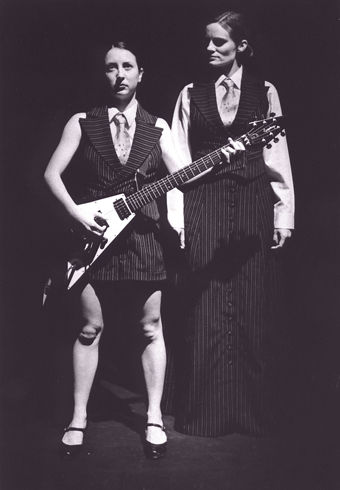 |
Lisa O’Neill and Christie Johnston in All Tomorrow’s Parties 1 and 2 photo Jodie Ranger |
The latter two collectives have fostered the continued development of many of the movement-based performers in Cab/Sav. The evening opened with Caroline Dunphy’s flippant flight attendant, complete with flashing semaphore wrist bands. The frivolity of her piece Transonic—a monologue in few words was the exception in an evening of somewhat sombre pieces.
Christina Koch’s Giant’s Hopscotch Party, was an innocently executed dance of death which showed the macabre joy of a giant crushing ‘the little people’ with various Suzuki influenced walks and stomps. Although the piece lost focus towards the end as the movement became smaller and more intimate, it was one of the few performances I have seen where heightened Suzuki movements actually drove the narrative.
A strong physical presence continued with Brian Lucas’ take on war, religion, politics and Patsy Cline in psycho/the/rapist #3—joan of arc. In his simple adjustment of a skirt, Lucas transformed from a hooded, softly spoken, petite Joan of Arc into a towering queen dancing to Patsy Cline. His repetitive use of movement, recorded and spoken text and music created several personae though the connections between them were not always clear. Several images from John Utans and Jason Wollington’s performance remained long after their piece ended, particularly the chalk outline of one of their bodies traced after an intense contact improvisation. Unfortunately, the physical subtleties were often combined with slides of heavy-handed text.
A complete departure from the physical was Shugafix, a selection of songs sung and melodramatically gestured by Lucinda Shaw accompanied beautifully on cello by David Sells. Technical difficulties made the lyrics almost impossible to understand and as the audience were quite adept at reading bodies by this stage of the evening, this still and self-absorbed performance seemed rather incongruous. Mark McInnes, however, managed to successfully traverse my physical expectations of the night in his understated Four Songs. McInnes’ exquisite command of both French (La Vie en Rose) and German (Falling in Love Again), his soft camp introductory patter and his confidence in his own stillness created the intimate cabaret atmosphere promised in the production’s title.
By far the highlight of the evening and the crucial performances that both linked and questioned the separation of the voice from the body was the combination of one of Brisbane’s most talented experimental vocalists (Christine Johnston) with one of our most inspiring physical performers (Lisa O’Neill). In All Tomorrows Parties 1 and 2, Johnston used such diverse musical influences as the humble Hammond organ, Velvet Underground, Bach and the theme from the film Orlando to contrast with O’Neill’s tap-dancing, Suzuki-stomping and sassy dancing. The dead-pan expressions, dry humour and occasional stealing of looks from one another created a sense of two aesthetically similar performers desiring each other’s inherently different forms of expression. Throughout both pieces, we gradually saw each performer attempt the other’s skill, from O’Neill hesitantly joining Johnston on the organ to Johnston’s slow walking exit from the space. The final image of the night gave the impression that the physical and the musical can successfully embrace each other with O’Neill’s sudden possession of the Flying V guitar.
Overall, Cab/Sav may have benefited from a curator or an outside eye. It seemed that the event was drawing on a cabaret format, however, the relatively serious ‘theatre’ atmosphere and absence of alcohol at Metro Arts created an environment where the audience were less able to relax. As a season of short works, Cab/Sav continued local queer performers’ exploration of conceptually mature vocal and physical vignettes which would give its Sydney counterpart, cLUB bENT, a run for its money.
Cab/Sav, Lesbian and Gay Pride Festival, Metro Arts Theatre, June 17 - 20
Stacey Callaghan is a physical theatre performer, writer and director. She is currently devising when i was a boy, a solo circus theatre performance which explores the concepts of trust, risk, pain and safety inherent in both physical performance and intimate relationships.
RealTime issue #26 Aug-Sept 1998 pg. 43
© Stacey Callaghan; for permission to reproduce apply to [email protected]








 back
back